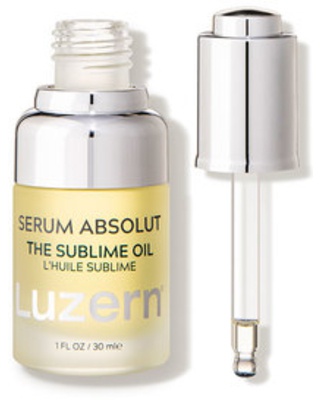
The Sublime Oil
Ingredients overview
Highlights
Skim through
| Ingredient name | what-it-does | irr., com. | ID-Rating |
|---|---|---|---|
| Squalane* | skin-identical ingredient, emollient | 0, 1 | goodie |
| Simmondsia Chinensis (Jojoba) Seed Oil** | emollient | 0, 0-2 | goodie |
| Rosa Affinis Rubiginosa (Rosehip) Oil** | antioxidant, emollient | goodie | |
| Rosmarinus Officinalis (Rosemary) Leaf Extract* | antioxidant, soothing, antimicrobial/antibacterial | goodie | |
| Buddleja Davidii Extract** | |||
| Leontopodium Alpinum (Edelweiss) Extract** | |||
| Thymus Vulgaris (Thyme) Extract** | perfuming | ||
| Lavandula Angustifolia (Lavender) Oil* | antimicrobial/antibacterial, perfuming | icky | |
| Citrus Aurantium Dulcis (Orange) Oil** | perfuming | icky |
Luzern Laboratories The Sublime OilIngredients explained
It seems to us that squalane is in fashion and there is a reason for it. Chemically speaking, it is a saturated (no double bonds) hydrocarbon (a molecule consisting only of carbon and hydrogen), meaning that it's a nice and stable oily liquid with a long shelf life.
It occurs naturally in certain fish and plant oils (e.g. olive), and in the sebum (the oily stuff our skin produces) of the human skin. As f.c. puts it in his awesome blog post, squalane's main things are "emolliency, surface occlusion, and TEWL prevention all with extreme cosmetic elegance". In other words, it's a superb moisturizer that makes your skin nice and smooth, without being heavy or greasy.
Jojoba is a drought resistant evergreen shrub native to South-western North America. It's known and grown for jojoba oil, the golden yellow liquid coming from the seeds (about 50% of the weight of the seeds will be oil).
At first glance, it seems like your average emollient plant oil: it looks like an oil and it's nourishing and moisturizing to the skin but if we dig a bit deeper, it turns out that jojoba oil is really special and unique: technically - or rather chemically - it's not an oil but a wax ester (and calling it an oil is kind of sloppy).
The oil coming from the seeds of the wild rose bush most common in the southern Andes in Chile (btw, Rosa Rubiginosa, Rosa Eglanteria and Rosa Mosqueta all refer to the same oil, however, the more commonly used Rosa Canina is a bit different). Similar to many other great plant oils, it is a nice nourishing and moisturizing oil loaded with fatty acids (linoleic acid - 44%, linolenic acid - 34% and oleic acid - 14%).
What makes rosehip oil a special snowflake among all the plant oils out there is that it also contains the miracle active, trans-retinoic acid, aka tretinoin. It is the main bioactive component of the oil and has all kinds of magic abilities including restoring and regenerating tissues (the oil is great for scars and burns), decreasing wrinkles, helping acne and even normalizing pore size.
The extract coming from the lovely herb, rosemary. It contains lots of chemicals, including flavonoids, phenolic acids, and diterpenes. Its main active is rosmarinic acid, a potent antioxidant, and anti-inflammatory. It has also anti-bacterial, astringent and toning properties.
The leaves contain a small amount of essential oil (1-2%) with fragrant components, so if you are allergic to fragrance, it might be better to avoid it.



We have to start by writing how fascinated we are by the amazing lavender fields of Provance and we do love pretty much everything about lavender: its look, its color, its scent.... but, when it comes to skincare, lavender is a questionable ingredient that you probably do not want in your skincare products.
First, let us start with the pros: it has a lovely scent, so no wonder that it is popular as a fragrance ingredient in natural products wanting to be free from synthetic fragrances but still wanting to smell nice. The scent of lavender is famous for having calming and relaxing properties and some smallish scientific studies do support that. Inhaled volatile compounds seem to have a soothing effect on the central nervous system and studies have shown that lavender aromatherapy can improve patient's anxiety and experience in hospitals.
The essential oil coming from the sweet orange. In the case of orange (and citruses in general), the essential oil is mainly in the peel of the fruit, so it's pretty much the same as the orange peel oil (also has the same CAS number - a unique ID assigned to chemicals).
Its main component is limonene (up to 97%), a super common fragrant ingredient that makes everything smell nice (but counts as a frequent skin sensitizer).
You may also want to take a look at...
| what‑it‑does | skin-identical ingredient | emollient |
| irritancy, com. | 0, 1 |
| what‑it‑does | emollient |
| irritancy, com. | 0, 0-2 |
| what‑it‑does | antioxidant | emollient |
| what‑it‑does | antioxidant | soothing | antimicrobial/antibacterial |
| what‑it‑does | perfuming |
| what‑it‑does | antimicrobial/antibacterial | perfuming |
| what‑it‑does | perfuming |





